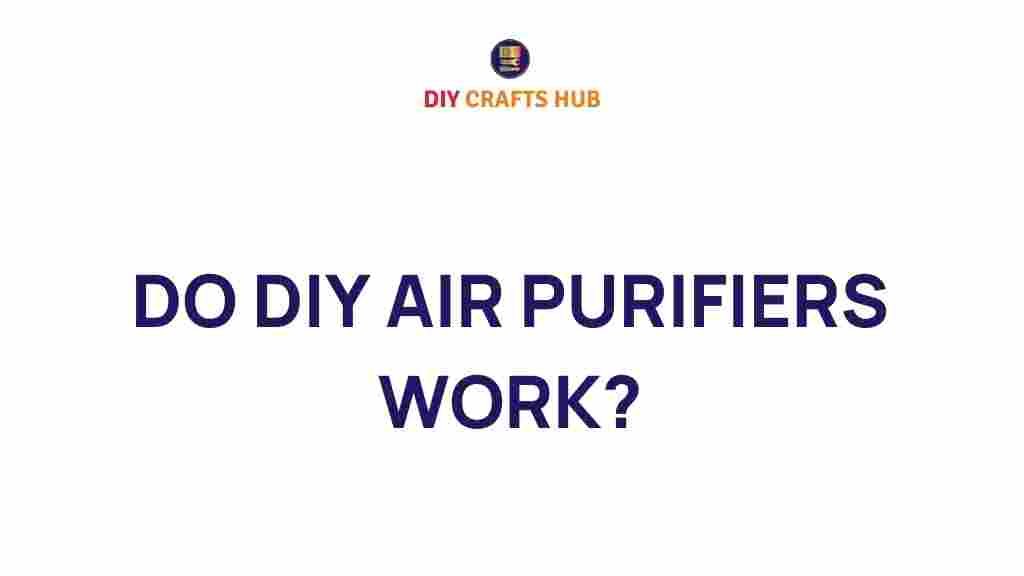Indoor air quality is a growing concern, with pollutants like dust, pet dander, and volatile organic compounds (VOCs) affecting our health. While commercial air purifiers are effective, they can be costly. Enter DIY air purifiers, an inexpensive and accessible solution touted by many. But do they really work? Let’s dive into the science, methods, and practical aspects to uncover the truth.
Do DIY Air Purifiers Really Work?
DIY air purifiers have gained popularity as a budget-friendly alternative to expensive commercial models. These homemade devices aim to improve indoor air quality using common household items like fans, filters, and even activated charcoal. But are they effective enough to compete with their commercial counterparts?
The effectiveness of a DIY air purifier depends on various factors, including the type of filter used, room size, and the concentration of airborne particles. While they can help reduce some pollutants, they might not address all air quality concerns. Understanding how they work and their limitations is crucial for making an informed choice.
How DIY Air Purifiers Work
DIY air purifiers typically function by combining a fan with a filter, such as a high-efficiency particulate air (HEPA) filter or furnace filter. The fan draws in air, which then passes through the filter to trap pollutants like dust, allergens, and smoke particles. The filtered air is recirculated into the room, improving air quality.
Additional components like activated charcoal can be used to absorb odors and VOCs, making these DIY solutions versatile. However, the design and materials significantly impact their overall efficiency.
Benefits of DIY Air Purifiers
- Cost-effectiveness: Building your own air purifier is typically much cheaper than purchasing a commercial unit.
- Customization: You can tailor the purifier to suit your specific needs, such as targeting allergens or odors.
- Easy to assemble: Most designs require minimal tools and can be created in under an hour.
- Eco-friendly: Reusing household items can reduce waste and promote sustainability.
How to Build an Effective DIY Air Purifier
Creating a DIY air purifier is a straightforward process. Below, we outline a step-by-step guide to building an efficient and reliable homemade air purifier.
Materials Needed
- Box fan (20 inches or similar size)
- High-quality HEPA or MERV-rated furnace filter
- Duct tape or bungee cords
- Optional: Activated charcoal filters for odor and VOC removal
Step-by-Step Instructions
- Choose the right filter: Select a HEPA or MERV-13 filter for maximum efficiency in trapping small particles like allergens and dust.
- Attach the filter to the fan: Place the filter on the back of the fan, ensuring the airflow direction marked on the filter aligns with the fan’s intake. Secure it with duct tape or bungee cords.
- Test the setup: Turn on the fan and observe whether the filter remains securely attached. Ensure there are no gaps that could allow unfiltered air to bypass the system.
- Enhance for odor removal: If desired, attach an activated charcoal filter to absorb odors and VOCs.
Tips for Optimal Performance
- Use a high-quality filter: Low-grade filters might not capture smaller particles like allergens effectively.
- Replace filters regularly: Clogged filters reduce efficiency. Replace them as per the manufacturer’s recommendations or sooner if needed.
- Position strategically: Place the air purifier in high-traffic areas or near pollution sources for maximum impact.
Troubleshooting Common Issues with DIY Air Purifiers
Despite their simplicity, DIY air purifiers can face challenges. Here are some common issues and how to address them:
Problem: Weak Airflow
Solution: Check if the filter is too dense or clogged. Opt for a filter with a suitable MERV rating that balances efficiency and airflow. Clean or replace the filter as needed.
Problem: Noise Levels
Solution: Reduce the fan speed if it offers multiple settings. Ensure the filter is securely attached to minimize vibrations and noise.
Problem: Limited Coverage
Solution: DIY air purifiers are best for small to medium-sized rooms. Use multiple units for larger spaces or consider upgrading to a commercial purifier for extensive coverage.
Are DIY Air Purifiers Worth the Effort?
While DIY air purifiers can improve air quality, they come with limitations. Their primary strength lies in affordability and customization, making them a viable option for those on a budget or in need of a temporary solution. However, for comprehensive air purification—especially in homes with high pollution levels or health concerns—a commercial air purifier may be more reliable.
Additionally, understanding the science behind filtration is crucial. A well-built DIY air purifier can significantly reduce particulate matter but might not be as effective at removing VOCs or microscopic pathogens.
For those exploring indoor air quality solutions, combining a DIY air purifier with other strategies like regular cleaning, proper ventilation, and reducing pollutant sources can yield the best results.
Conclusion
In conclusion, DIY air purifiers offer a cost-effective way to improve indoor air quality. They are easy to build, customizable, and can significantly reduce allergens and pollutants in small spaces. However, their effectiveness depends on the materials used and how well they are constructed.
If you’re considering a DIY air purifier, follow the steps above and experiment with different filters to optimize performance. For more tips on improving indoor air quality, check out our comprehensive guide.
Ultimately, whether DIY or commercial, ensuring cleaner air is a step toward better health and well-being for you and your family.
This article is in the category Home & Decor and created by DIYCraft Team
